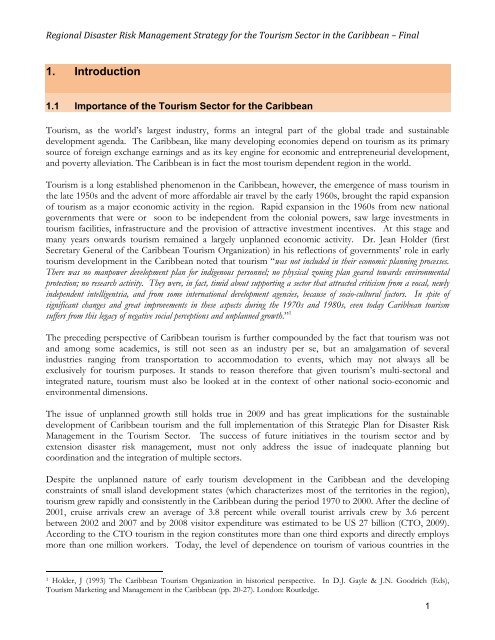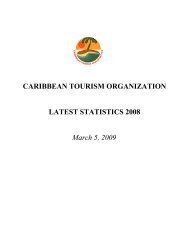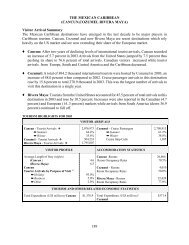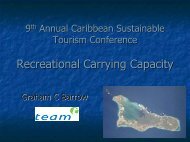Disaster Risk Management Strategy and Plan of Action - Caribbean ...
Disaster Risk Management Strategy and Plan of Action - Caribbean ...
Disaster Risk Management Strategy and Plan of Action - Caribbean ...
You also want an ePaper? Increase the reach of your titles
YUMPU automatically turns print PDFs into web optimized ePapers that Google loves.
Regional <strong>Disaster</strong> <strong>Risk</strong> <strong>Management</strong> <strong>Strategy</strong> for the Tourism Sector in the <strong>Caribbean</strong> – Final<br />
1. Introduction<br />
1.1 Importance <strong>of</strong> the Tourism Sector for the <strong>Caribbean</strong><br />
Tourism, as the world’s largest industry, forms an integral part <strong>of</strong> the global trade <strong>and</strong> sustainable<br />
development agenda. The <strong>Caribbean</strong>, like many developing economies depend on tourism as its primary<br />
source <strong>of</strong> foreign exchange earnings <strong>and</strong> as its key engine for economic <strong>and</strong> entrepreneurial development,<br />
<strong>and</strong> poverty alleviation. The <strong>Caribbean</strong> is in fact the most tourism dependent region in the world.<br />
Tourism is a long established phenomenon in the <strong>Caribbean</strong>, however, the emergence <strong>of</strong> mass tourism in<br />
the late 1950s <strong>and</strong> the advent <strong>of</strong> more affordable air travel by the early 1960s, brought the rapid expansion<br />
<strong>of</strong> tourism as a major economic activity in the region. Rapid expansion in the 1960s from new national<br />
governments that were or soon to be independent from the colonial powers, saw large investments in<br />
tourism facilities, infrastructure <strong>and</strong> the provision <strong>of</strong> attractive investment incentives. At this stage <strong>and</strong><br />
many years onwards tourism remained a largely unplanned economic activity. Dr. Jean Holder (first<br />
Secretary General <strong>of</strong> the <strong>Caribbean</strong> Tourism Organization) in his reflections <strong>of</strong> governments’ role in early<br />
tourism development in the <strong>Caribbean</strong> noted that tourism “was not included in their economic planning processes.<br />
There was no manpower development plan for indigenous personnel; no physical zoning plan geared towards environmental<br />
protection; no research activity. They were, in fact, timid about supporting a sector that attracted criticism from a vocal, newly<br />
independent intelligentsia, <strong>and</strong> from some international development agencies, because <strong>of</strong> socio-cultural factors. In spite <strong>of</strong><br />
significant changes <strong>and</strong> great improvements in these aspects during the 1970s <strong>and</strong> 1980s, even today <strong>Caribbean</strong> tourism<br />
suffers from this legacy <strong>of</strong> negative social perceptions <strong>and</strong> unplanned growth.” 1<br />
The preceding perspective <strong>of</strong> <strong>Caribbean</strong> tourism is further compounded by the fact that tourism was not<br />
<strong>and</strong> among some academics, is still not seen as an industry per se, but an amalgamation <strong>of</strong> several<br />
industries ranging from transportation to accommodation to events, which may not always all be<br />
exclusively for tourism purposes. It st<strong>and</strong>s to reason therefore that given tourism’s multi-sectoral <strong>and</strong><br />
integrated nature, tourism must also be looked at in the context <strong>of</strong> other national socio-economic <strong>and</strong><br />
environmental dimensions.<br />
The issue <strong>of</strong> unplanned growth still holds true in 2009 <strong>and</strong> has great implications for the sustainable<br />
development <strong>of</strong> <strong>Caribbean</strong> tourism <strong>and</strong> the full implementation <strong>of</strong> this Strategic <strong>Plan</strong> for <strong>Disaster</strong> <strong>Risk</strong><br />
<strong>Management</strong> in the Tourism Sector. The success <strong>of</strong> future initiatives in the tourism sector <strong>and</strong> by<br />
extension disaster risk management, must not only address the issue <strong>of</strong> inadequate planning but<br />
coordination <strong>and</strong> the integration <strong>of</strong> multiple sectors.<br />
Despite the unplanned nature <strong>of</strong> early tourism development in the <strong>Caribbean</strong> <strong>and</strong> the developing<br />
constraints <strong>of</strong> small isl<strong>and</strong> development states (which characterizes most <strong>of</strong> the territories in the region),<br />
tourism grew rapidly <strong>and</strong> consistently in the <strong>Caribbean</strong> during the period 1970 to 2000. After the decline <strong>of</strong><br />
2001, cruise arrivals crew an average <strong>of</strong> 3.8 percent while overall tourist arrivals crew by 3.6 percent<br />
between 2002 <strong>and</strong> 2007 <strong>and</strong> by 2008 visitor expenditure was estimated to be US 27 billion (CTO, 2009).<br />
According to the CTO tourism in the region constitutes more than one third exports <strong>and</strong> directly employs<br />
more than one million workers. Today, the level <strong>of</strong> dependence on tourism <strong>of</strong> various countries in the<br />
1 Holder, J (1993) The <strong>Caribbean</strong> Tourism Organization in historical perspective. In D.J. Gayle & J.N. Goodrich (Eds),<br />
Tourism Marketing <strong>and</strong> <strong>Management</strong> in the <strong>Caribbean</strong> (pp. 20-27). London: Routledge.<br />
1

















